Search the Blog
Categories
- Books & Reading
- Broadband Buzz
- Census
- Education & Training
- Friday Reads
- General
- Grants
- Information Resources
- Library Management
- Nebraska Center for the Book
- Nebraska Libraries on the Web
- Nebraska Memories
- Now hiring @ your library
- Preservation
- Pretty Sweet Tech
- Programming
- Public Library Boards of Trustees
- Public Relations
- Talking Book & Braille Service (TBBS)
- Technology
- Uncategorized
- What's Up Doc / Govdocs
- Youth Services
Archives
Subscribe
Category Archives: Information Resources
What’s Up Doc? New State Agency Publications at the Nebraska Library Commission
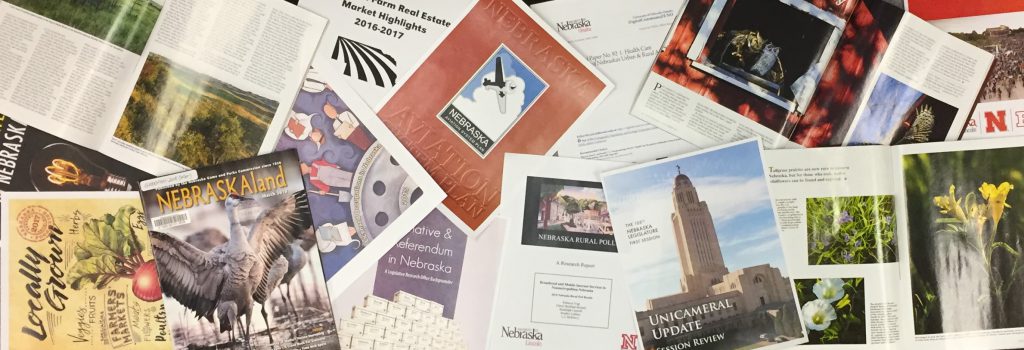
New state agency publications have been received at the Nebraska Library Commission for July and August 2020. Included are reports from the Nebraska Abstracters Board of Examiners, the Nebraska State Board of Public Accountancy, the Nebraska Accountability and Disclosure Commission, the Nebraska Commission for the Deaf and Hard of Hearing, and new books from the University of Nebraska Press, to name a few.
Most items, except the books from the University of Nebraska Press, are available for immediate viewing and printing by clicking on the highlighted link above, or directly in the .pdf below. You can read synopses of the books received from the University of Nebraska Press in the Book Briefs blogposts.
The Nebraska Legislature created the Nebraska Publications Clearinghouse in 1972, a service of the Nebraska Library Commission. Its purpose is to collect, preserve, and provide access to all public information published by Nebraska state agencies. By law (State Statutes 51-411 to 51-413) all Nebraska state agencies are required to submit their published documents to the Clearinghouse. For more information, visit the Nebraska Publications Clearinghouse page, contact Mary Sauers, Government Information Services Librarian; or contact Bonnie Henzel, State Documents Staff Assistant.
Friday Reads: The Lending Library, by Aliza Fogelson

What would you do if your town library closed for renovations, and the nearest library is an hour’s drive away? Read The Lending Library, by Aliza Fogelson to find out what one women did in just such a situation…
When the Chatsworth library closes indefinitely, Dodie Fairisle loses her sanctuary. How is a small-town art teacher supposed to cope without the never-ending life advice and enjoyment that books give her? Well, when she’s as resourceful and generous as Dodie, she turns her sunroom into her very own little lending library.
At first just a hobby, this lit lovers’ haven opens up her world in incredible ways. She knows books are powerful, and soon enough they help her forge friendships between her zany neighbors—and attract an exciting new romance.
But when the chance to adopt an orphaned child brings Dodie’s secret dream of motherhood within reach, everything else suddenly seems less important. Finding herself at a crossroads, Dodie must figure out what it means to live a full, happy life. If only there were a book that could tell her what to do…
I read The Lending Library, by Aliza Fogelson, in the Kindle format, and thoroughly enjoyed it. This is a lovely debut novel that teaches us how important libraries are to individuals, families, friends, and communities. Definitely an excellent read!
Book Briefs: New University of Nebraska Press Books at the Nebraska Publications Clearinghouse

The Nebraska Publications Clearinghouse receives documents every month from all Nebraska state agencies, including the University of Nebraska Press (UNP). Each month we will be showcasing the UNP books that the Clearinghouse receives. UNP books, as well as all Nebraska state documents, are available for checkout by libraries and librarians, for their patrons, in Nebraska.
Here are the UNP books the Clearinghouse received in May and June 2020:
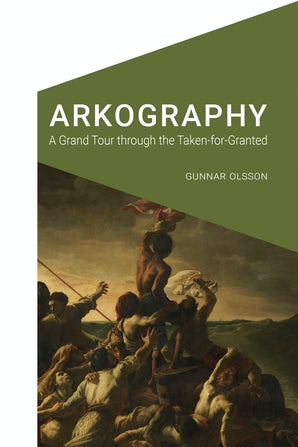
Arkography : A Grand Tour Through the Taken-for-Granted Gunnar Olsson (Series: Cultural Geographies + Rewriting the Earth)
In this fascinating text Gunnar Olsson tells the story of an arkographer, who with Pallas Athene’s blessings, travels down the Red River Valley, navigates the Kantian Island of Truth, and takes a house-tour through the Crystal Palace, the latter edifice an imagination grown out of Gunnael Jensson’s sculpture Mappa Mundi Universalis. This travel story carries the arkographer from the oldest creation epics extant to the power struggles of today—nothing less than a codification of the taken-for-granted, a mapping of the no-man’s-land between the five senses of the body and the sixth sense of culture. By constantly asking how we are made so obedient and predictable, the explorer searches for the present-day counterparts to the biblical ark, the chest that held the commandments and the rules of behavior that came with them—hence the term “arkography,” a word hinting at an as-yet-unrecognized discipline.
In Arkography Olsson strips bare the governing techniques of self-declared authorities, including those of the God of the Old Testament and countless dictators, the latter supported by a horde of lackeys often disguised as elected representatives and governmental functionaries. From beginning to end, Arkography is an illustration of how every creation epic is a variation on the theme of chaos turning into cosmic order. A palimpsest of layered meanings, a play of things and relations, identity and difference. One and many, you and me.
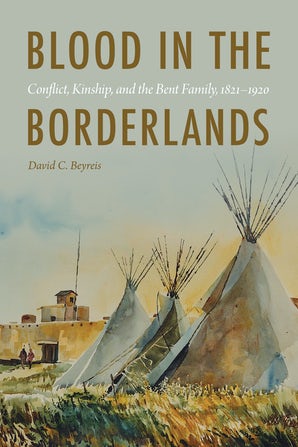
Blood in the Borderlands : Conflict, Kinship, and the Bent Family, 1821-1920 David C. Beyreis
The Bents might be the most famous family in the history of the American West. From the 1820s to 1920 they participated in many of the major events that shaped the Rocky Mountains and Southern Plains. They trapped beaver, navigated the Santa Fe Trail, intermarried with powerful Indian tribes, governed territories, became Indian agents, fought against the U.S. government, acquired land grants, and created historical narratives.
The Bent family’s financial and political success through the mid-nineteenth century derived from the marriages of Bent men to women of influential borderland families—New Mexican and Southern Cheyenne. When mineral discoveries, the Civil War, and railroad construction led to territorial expansions that threatened to overwhelm the West’s oldest inhabitants and their relatives, the Bents took up education, diplomacy, violence, entrepreneurialism, and the writing of history to maintain their status and influence.
In Blood in the Borderlands David C. Beyreis provides an in-depth portrait of how the Bent family creatively adapted in the face of difficult circumstances. He incorporates new material about the women in the family and the “forgotten” Bents and shows how indigenous power shaped the family’s business and political strategies as the family adjusted to American expansion and settler colonist ideologies. The Bent family history is a remarkable story of intercultural cooperation, horrific violence, and pragmatic adaptability in the face of expanding American power.
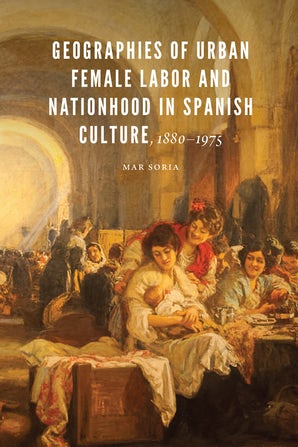
Geographies of Urban Female Labor and Nationhood in Spanish Culture, 1880-1975 Mar Soria (Series: New Hispanisms)
Mar Soria presents an innovative cultural analysis of female workers in Spanish literature and films. Drawing from nation-building theories, the work of feminist geographers, and ideas about the construction of the marginal subject in society, Soria examines how working women were perceived as Other in Spain from 1880 to 1975.
By studying the representation of these marginalized individuals in a diverse array of cultural artifacts, Soria contends that urban women workers symbolized the desires and anxieties of a nation caught between traditional values and rapidly shifting socioeconomic forces. Specifically, the representation of urban female work became a mode of reinforcing and contesting dominant discourses of gender, class, space, and nationhood in critical moments after 1880, when social and economic upheavals resulted in fears of impending national instability. Through these cultural artifacts Spaniards wrestled with the unresolved contradictions in the gender and class ideologies used to construct and maintain the national imaginary.
Whether for reasons of inattention or disregard of issues surrounding class dynamics, nineteenth- and twentieth-century Spanish literary and cultural critics have assumed that working women played only a minimal role in the development of Spain as a modern nation. As a result, relatively few critics have investigated cultural narratives of female labor during this period. Soria demonstrates that without considering the role working women played in the construction and modernization of Spain, our understanding of Spanish culture and life at that time remains incomplete.

Matters of Justice : Pueblos, the Judiciary, and Agrarian Reform in Revolutionary Mexico Helga Baltenmann (Series: The Mexican Experience)
After the fall of the Porfirio Díaz regime, pueblo representatives sent hundreds of petitions to Pres. Francisco I. Madero, demanding that the executive branch of government assume the judiciary’s control over their unresolved lawsuits against landowners, local bosses, and other villages. The Madero administration tried to use existing laws to settle land conflicts but always stopped short of invading judicial authority.
In contrast, the two main agrarian reform programs undertaken in revolutionary Mexico—those implemented by Emiliano Zapata and Venustiano Carranza—subordinated the judiciary to the executive branch and thereby reshaped the postrevolutionary state with the support of villagers, who actively sided with one branch of government over another.
In Matters of Justice Helga Baitenmann offers the first detailed account of the Zapatista and Carrancista agrarian reform programs as they were implemented in practice at the local level and then reconfigured in response to unanticipated inter- and intravillage conflicts. Ultimately, the Zapatista land reform, which sought to redistribute land throughout the country, remained an unfulfilled utopia. In contrast, Carrancista laws, intended to resolve quickly an urgent problem in a time of war, had lasting effects on the legal rights of millions of land beneficiaries and accidentally became the pillar of a program that redistributed about half the national territory.

Out of the Crazywoods Cheryl Savageau (Series: American Indian Lives)
Out of the Crazywoods is the riveting and insightful story of Abenaki poet Cheryl Savageau’s late-life diagnosis of bipolar disorder. Without sensationalizing, she takes the reader inside the experience of a rapid-cycling variant of the disorder, providing a lens through which to understand it and a road map for navigating the illness. The structure of her story—impressionistic, fragmented—is an embodiment of the bipolar experience and a way of perceiving the world.
Out of the Crazywoods takes the reader into the euphoria of mania as well as its ugly, agitated rage and into “the lying down of desire” that is depression. Savageau articulates the joy of being consort to a god and the terror of being chased by witchcraft, the sound of voices that are always chattering in your head, the smell of wet ashes that invades your home, the perception that people are moving in slow motion and death lurks at every turnpike, and the feeling of being loved by the universe and despised by everyone you’ve ever known.
Central to the journey out of the Crazywoods is the sensitive child who becomes a poet and writer who finds clarity in her art and a reason to heal in her grandchildren. Her journey reveals the stigma and the social, personal, and economic consequences of the illness but reminds us that the disease is not the person. Grounded in Abenaki culture, Savageau questions cultural definitions of madness and charts a path to recovery through a combination of medications, psychotherapy, and ceremony.
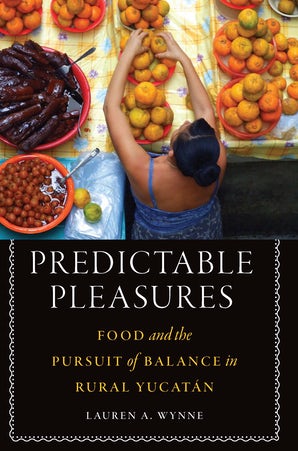
Predictable Pleasures : Food and the Pursuit of Balance In Rural Yucatan Lauren A Wynne (Series: At Table)
The pursuit of balance pervades everyday life in rural Yucatán, Mexico, from the delicate negotiations between a farmer and the neighbor who wants to buy his beans to the careful addition of sour orange juice to a rich plate of eggs fried in lard. Based on intensive fieldwork in one indigenous Yucatecan community, Predictable Pleasures explores the desire for balance in this region and the many ways it manifests in human interactions with food. As shifting social conditions, especially a decline in agriculture and a deepening reliance on regional tourism, transform the manners in which people work and eat, residents of this community grapple with new ways of surviving and finding pleasure.
Lauren A. Wynne examines the convergence of food and balance through deep analysis of what locals describe as acts of care. Drawing together rich ethnographic data on how people produce, exchange, consume, and talk about food, this book posits food as an accessible, pleasurable, and deeply important means by which people in rural Yucatán make clear what matters to them, finding balance in a world that seems increasingly imbalanced.
Unlike many studies of globalization that point to the dissolution of local social bonds and practices, Predictable Pleasures presents an array of enduring values and practices, tracing their longevity to the material constraints of life in rural Yucatán, the deep historical and cosmological significance of food in this region, and the stubborn nature of bodily habits and tastes.

The Storied Landscape of Iroquoia : History, Conquest, and Memory in the Native Northeast Chad L. Anderson (Series: Borderlands and Transcultural Studies)
The Storied Landscape of Iroquoia explores the creation, destruction, appropriation, and enduring legacy of one of early America’s most important places: the homelands of the Haudenosaunees (also known as the Iroquois Six Nations). Throughout the late seventeenth, eighteenth, and early nineteenth centuries of European colonization the Haudenosaunees remained the dominant power in their homelands and one of the most important diplomatic players in the struggle for the continent following European settlement of North America by the Dutch, British, French, Spanish, and Russians. Chad L. Anderson offers a significant contribution to understanding colonialism, intercultural conflict, and intercultural interpretations of the Iroquoian landscape during this time in central and western New York.
Although American public memory often recalls a nation founded along a frontier wilderness, these lands had long been inhabited in Native American villages, where history had been written on the land through place-names, monuments, and long-remembered settlements. Drawing on a wide range of material spanning more than a century, Anderson uncovers the real stories of the people—Native American and Euro-American—and the places at the center of the contested reinvention of a Native American homeland. These stories about Iroquoia were key to both Euro-American and Haudenosaunee understandings of their peoples’ pasts and futures.
For more information about The Storied Landscape of Iroquoia, visit storiedlandscape.com.
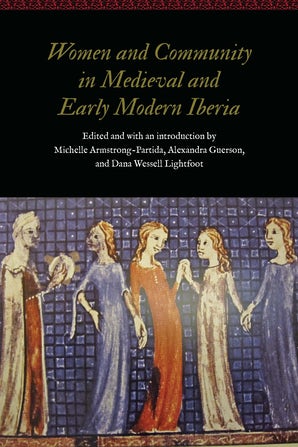
Women and Community in Medieval and Early Modern Iberia Edited and with an introduction by Michelle Armstrong-Partida, Alexandra Guerson, and Dana Wessell Lightfoot ; Series: Women and Gender in the Early Modern World
Women and Community in Medieval and Early Modern Iberia draws on recent research to underscore the various ways Iberian women influenced and contributed to their communities, engaging with a broader academic discussion of women’s agency and cultural impact in the Iberian Peninsula. By focusing on women from across the socioeconomic and religious spectrum—elite, bourgeois, and peasant Christian women, Jewish, Muslim, converso, and Morisco women, and married, widowed, and single women—this volume highlights the diversity of women’s experiences, examining women’s social, economic, political, and religious ties to their families and communities in both urban and rural environments.
Comprised of twelve essays from both established and new scholars, Women and Community in Medieval and Early Modern Iberia showcases groundbreaking work on premodern women, revealing the complex intersections between gender and community while highlighting not only relationships of support and inclusion but also the tensions that worked to marginalize and exclude women.
**All synopses courtesy of University of Nebraska Press (https://www.nebraskapress.unl.edu/)
What’s Up Doc? New State Agency Publications at the Nebraska Library Commission

New state agency publications have been received at the Nebraska Library Commission for May and June 2020. Included are audit reports from the Nebraska Auditor of Public Accounts, reports from the Nebraska Department of Economic Development, and new books from the University of Nebraska Press, to name a few.
Most items, except the books from the University of Nebraska Press, are available for immediate viewing and printing by clicking on the highlighted link above, or directly in the .pdf below. You can read synopses of the books received from the University of Nebraska Press in the Book Briefs blogposts.
The Nebraska Legislature created the Nebraska Publications Clearinghouse in 1972, a service of the Nebraska Library Commission. Its purpose is to collect, preserve, and provide access to all public information published by Nebraska state agencies. By law (State Statutes 51-411 to 51-413) all Nebraska state agencies are required to submit their published documents to the Clearinghouse. For more information, visit the Nebraska Publications Clearinghouse page, contact Mary Sauers, Government Information Services Librarian; or contact Bonnie Henzel, State Documents Staff Assistant.
Free ALA webinar: “Last Chance for a Complete Count”

| ALA is offering a webinar for library staff: 2020 Census: Last Chance for a Complete Count, on July 8 at 2 pm ET. Registration is free. After the session, the recording will be posted at ala.org/census. New guide on adapting census outreach in response to COVID-19: ALA released a new publication, “Libraries and the 2020 Census: Adapting Outreach in Response to COVID-19 (PDF).” The free guide explains changes to the 2020 Census process and highlights opportunities for libraries to adapt census outreach activities. Check your community’s response rate: How does your area compare in its response rate to date? Which neighborhoods are lagging behind? Find current data to inform your outreach and messages on the 2020 Census Response Rate Map or the Census 2020 Hard to Count Map. Share your event on the Census Counts calendar: Is your library planning a 2020 Census event (including virtual events)? Submit it to the national Census Counts calendar. Check the calendar for other events from partners in your community. |
Accreditation Suspended, Data Available
This year, the accreditation cycle has been suspended due to COVID-19. However, our FY2019 data, what would have been used on your accreditation applications, is available. For those libraries that might be planning and want to see how you compare to what would have been your peers, contact me and I will send you your customized data set. Keep in mind that if you are up for re-accreditation next year, your peers may change. Typically, your peers are libraries that are within 15% of your legal service area. While there may be some exceptions to this, generally speaking those are the libraries that yours is compared to.
Reading For Change: Anti-Racism Titles in Our Book Club Kit Collection
Earlier this week, the New York Public Library’s Schomburg Center for Research in Black Culture posted their Black Liberation Reading List. This is among many anti-racism reading lists publicized in recent days (here, here, and here) but I’m choosing to highlight this list because the Schomburg Center has focused on the Black experience, history, and culture for 95 years. Their list of 95 books includes both fiction and nonfiction.
If your patrons or book club groups are interested in these titles, we have a selection of them in our Book Club Kit collection:
- The Autobiography of Malcolm X by Malcolm X
- The Bluest Eye by Toni Morrison
- I Know Why the Caged Bird Sings by Maya Angelou
- Just Mercy by Bryan Stevenson
- A Raisin in the Sun by Lorraine Hansberry
- Their Eyes Were Watching God by Zora Neale Hurston
- The Underground Railroad by Colson Whitehead
- The Warmth of Other Suns by Isabel Wilkerson
You can find these books and similar titles for all ages on our Book Club Kit page: http://nlc.nebraska.gov/ref/bookclub/, by choosing “Black lives” in the Genre drop down menu.
We have also gathered a number of resources for library patrons and the general public to learn about social issues on NebraskAccess.
Niche Academy is Open!
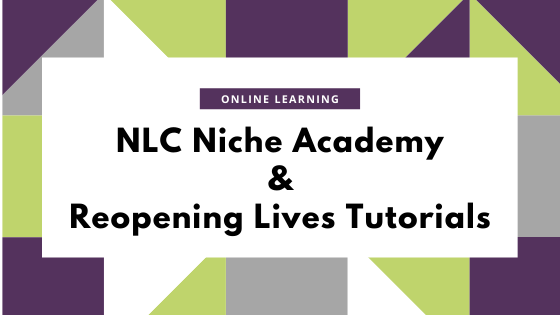
Two new online learning resources are now available!
First, the Nebraska Library Commission Academy is available to librarians as a thirty-day trial through Niche Academy. Lessons include topics such as:
- Code of Ethics for New Directors
- 10 Strategies for Community Organizing in Libraries
- 2020 United States Census
- Virtual Programming: Working with Presenters and Performers
- Research Essentials
Please check it out and let me know what you think! Each lesson is eligible for 1 CE credit for those enrolled in the Nebraska Public Librarian Certification program, just submit a CE Activity Report form when completed.
Second, the Reopening Lives Academy is a collaborative project between Niche Academy and librarians all over the United States to help answer patron questions as libraries work on reopening.
…many of us are anticipating a surge of patrons with questions about unemployment, taxes, and financial resources. We anticipate questions about public and personal health, and how the CARES act (and other legislation) will affect or help small businesses and entrepreneurs.
Niche Academy
These short tutorials are intended to help librarians and patrons answer these many different questions and provide quick resources with quality information on topics such as COVID-19, wearing masks, mental health, and writing resumes.
If you want to learn more about the collaborative project (or are interested in participating), there is more information posted on the Niche Academy blog.
2019 Public Library Survey Data is Now Available
 The 2019 FY public library survey data is now available on the NLC website. This is preliminary data (meaning that it has not yet been certified by IMLS) so keep in mind that it is subject to change. Thanks to all of you who submitted your statistics. Historical data (back to 1999) is also available on our website. The next survey cycle begins in November, but you should be collecting those statistics now. If you are a new library director, check out the Bibliostat guide.
The 2019 FY public library survey data is now available on the NLC website. This is preliminary data (meaning that it has not yet been certified by IMLS) so keep in mind that it is subject to change. Thanks to all of you who submitted your statistics. Historical data (back to 1999) is also available on our website. The next survey cycle begins in November, but you should be collecting those statistics now. If you are a new library director, check out the Bibliostat guide.
Reopening Your Library During the Pandemic

Is your library reopening to the public, or looking for guidance on reopening?
We’ve compiled recommendations and guidance from local and national organization, as well as example of policies and procedures being used by other Nebraska libraries here: http://nlc.nebraska.gov/libman/pandemic4libraries.aspx
If you’ve not yet told us that your library is reopening or modifying services for the pandemic, please fill out our form: https://docs.google.com/forms/d/e/1FAIpQLSe5AurxbSHsu5gy5sig7uHWkkQYeRG3EfT7l2ArfmbPTtlx-A/viewform.
A spreadsheet of Nebraska libraries closing, reopening, and modifying services can be found here: https://docs.google.com/spreadsheets/d/e/2PACX-1vQhzPpcpf_BAB_7wbDegLdjvfFX84AbGgRVAcIzrp-DYBIJUnKIaake5d1jKIRcFVW4qTPVwchtK5SV/pubhtml
And don’t forget our other resources for libraries and their patrons during this time: http://nlc.nebraska.gov/libman/pandemic.aspx
The Central Plains Libray System (CPLS) has resources too!
http://libraries.ne.gov/cpls/
Posted in General, Information Resources, Library Management
Tagged covid-19, pandemic, reopening, reopening plan
Leave a comment
Four Ways New Technology Is Revolutionizing the 2020 Census

From scribbled answers in 1790 to online responses in 2020, innovation has always been part of the Census. The Census Bureau has always been a leader in using, adapting and developing new technologies, but the 2020 Census will be the most sophisticated and high tech yet.
The census began in 1790 with collected information handwritten by U.S. Marshals visiting outposts in every corner of the new nation. Every decade since, the ways the U.S. Census Bureau has tried to meet its goal of counting every person living in the United States have undergone changes as dramatic as the growth of the nation itself.
Through the centuries, the decennial count progressed from in-person collections of handwritten answers to mass mailings of paper questionnaires in 1970. Among other changes along the way: creation of an electrical punch card tabulator for the 1890 Census and the first use by a government agency of the world’s first modern computer – the UNIVAC 1 – for the 1950 Census. It was developed by engineers John W. Mauchly and J. Presper Eckert, whose corporation was a division of Remington Rand.
In the previous century, Herman Hollerith, a former Census Office employee, invented a punch card tabulating machine used by the Census Bureau from the 1890 Census forward. Hollerith founded the Tabulating Machine Company, which eventually became International Business Machines (IBM).
America Counts spoke with Robert Colosi, a mathematical statistician in the Census Bureau’s Decennial Statistics Studies Division, about ways technology is revolutionizing the census.
He shared four specific changes that have had a major impact on how the Census Bureau counts everyone once, only once, and in the right place.
Innovation 1: Using Satellite Imagery to Check Addresses
Before the Census Bureau can count every person in the country, it must first collect addresses for every housing unit. One way the Census Bureau uses this address list is to mail census materials, including invitations to respond online, by phone or by mail.
Census Bureau employees used to “canvass” neighborhoods in person, jotting down new addresses and correcting old ones on paper.
This long-running operation, known as Address Canvassing, is one of the ways the Census Bureau updates its Master Address File or MAF. The Census Bureau also works with the United States Postal Service (USPS) to confirm already existing addresses on file.
Address canvassing was costly and time-consuming. Employees traveled a total of 137 million miles to update the MAF before the 2010 Census.
“The number of miles we traveled was astronomical,” Colosi said. “We’re not going to do that for the 2020 Census.”
In 2015, the Census Bureau began using aerial images from a network of satellites.
The Census Bureau developed computer software that allows employees in offices to compare satellite images from 2010 to new ones taken in real time. This helps them identify new houses, apartment buildings and other units to verify in the traditional Address Canvassing operation.
Thanks to the new In-Office Address Canvassing system, census workers reviewed 100% of all addresses in the United States for the 2020 Census and validated 65% in the office, removing them from the in-field workload.
That means workers needed to canvas fewer neighborhoods in person, saving time and money.
Address listers or canvassers hit the streets in August 2019 and completed the operation two months later, on track for the 2020 Census.
Innovation 2: Introducing Online Self-Response
The 2020 Census is the first time everyone has the option to respond to the census online as well as by phone or mail.
The Census Bureau has an Internet Self-Response tool designed to make it easy to complete the questionnaire online and keep responses secure. Directions for responding online will be included in letters, postcards and other mailings sent to most homes beginning in mid-March.
Every response submitted on the internet is encrypted. That means data are changed into a code that only Census Bureau data analysts can read. Responses travel through a secure cloud computer network and the Census Bureau locks them in a “digital vault”.
The Internet Self-Response instrument, the website for completing the census online, is available in English and 12 other languages.
Census Bureau employees, called census response representatives will also provide computers and tablets for access to the Internet Self-Response tool at places like libraries, community centers, health care centers and places of worship. This is particularly helpful in rural and other areas with limited or no internet access.
Innovation 3: Introducing Mobile Devices to Enumeration
From collecting census responses and job applications to storing questionnaires, the Census Bureau has used millions of pieces of paper to gather and file information. Now it relies much more on technology – and much less on paper.
In 2020, census takers who go door-to-door to help people respond will collect information on smartphones using a custom application created by the Census Bureau.
“The Systems Engineering and Integration Team created 52 systems in our ‘system of systems,’” Colosi said. “There’s a whole group of systems related to that one contract of enumeration and operations control. All of it was built by Census Bureau staff and contractors.”
To protect privacy, we encrypt all data and devices require two-factor authentication to be unlocked.
When a device connects to the internet, encrypted data immediately transmits to the Census Bureau’s digital vault – and is no longer on the device. Encrypted data are only stored on the devices until they connect to the internet.
Software in the smartphones also provides specific routes for census takers to follow to visit homes. Optimizing routes in this way helps census takers do their jobs more efficiently.
If a device is lost or stolen, the Census Bureau will remotely wipe it clean of all applications and information.
Innovation 4: New Ways to Protect Data
The Census Bureau is the leading source of quality data about the nation’s people and economy in its many surveys and programs, including the 2020 Census.
Opportunities to share and protect its data continue to grow with technology and innovation, particularly through data mashups.
Data mashups are algorithms that combine different data sources to expand graphical understanding of the data but can also find the origin of a particular set of data.
To protect against that, the Census Bureau has developed processes to protect its data from people who might try to make such mashups. Its Disclosure Avoidance System helps prevent improper disclosure of data. This addition is one of several advances the Census Bureau has made to safeguard an individual’s data.
“When we produced products in the old days, we didn’t have super high-tech and savvy users,” Colosi said. “The idea of computing data mashups to try and combine different data sources to find individual responses was not common. Now it is.”
All responses to the 2020 Census are confidential and protected by law. Title 13 of the Federal Code prohibits the Census Bureau from publishing or disclosing any private information, including names, addresses and telephone numbers.
“Our cybersecurity meets the latest, highest standards for protecting your information,” Census Bureau Chief Information Officer Kevin Smith said. “We work with industry experts to continually review and refine our approach to make sure we are staying ahead of threats and ensuring quick response. From the moment we collect your responses, our goal — and legal obligation — is to keep them safe.”
Census Bureau employees take an oath to keep your answers confidential. Violators face up to five years in prison and $250,000 in fines.
Posted in Books & Reading, Census, Education & Training, General, Information Resources, Technology, What's Up Doc / Govdocs
Tagged census
Leave a comment
Census Bureau Launches COVID-19 Data Hub
  The U.S. Census Bureau has released a new resource page on Census.gov to help federal The U.S. Census Bureau has released a new resource page on Census.gov to help federal agencies, businesses, and communities make decisions related to the COVID-19 pandemic. Similar to the Census Bureau’s resources pages created during natural disasters, this resource page includes information on population demographics, economic indicators and businesses. Learn More It features a new interactive data hub that centralizes already-released data from the American Community Survey and the County Business Patterns program to facilitate users’ access to data useful in pandemic-related decision making. The data hub, released as a beta version, will be updated periodically as the situation changes and as feedback is received from users.  You can sign up for COVID-19 Data Hub Updates here. You can sign up for COVID-19 Data Hub Updates here.  |
Posted in Books & Reading, Census, Education & Training, General, Information Resources, Technology, What's Up Doc / Govdocs
Tagged census
Leave a comment
2020 Census Updates
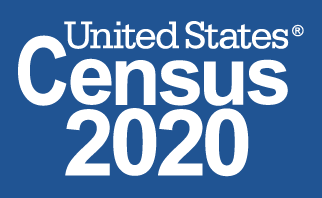
Nebraska is still FIRST in Census responses in our region! Here’s all the latest news from the Census Bureau:
Posted in Books & Reading, Census, Education & Training, General, Information Resources, What's Up Doc / Govdocs
Tagged census
Leave a comment
What’s Up Doc? New State Agency Publications at the Nebraska Library Commission

New state agency publications have been received at the Nebraska Library Commission for March and April 2020. Included are annual reports from a variety of Nebraska state agencies, economic development reports from the Nebraska Public Power District, Audit reports from the Nebraska Auditor of Public Accounts, and new books from the University of Nebraska Press, to name a few.
Most items, except the books from the University of Nebraska Press, are available for immediate viewing and printing by clicking on the highlighted link above, or directly in the .pdf below. You can read synopses of the books received from the University of Nebraska Press in the Book Briefs blogposts.
The Nebraska Legislature created the Nebraska Publications Clearinghouse in 1972, a service of the Nebraska Library Commission. Its purpose is to collect, preserve, and provide access to all public information published by Nebraska state agencies. By law (State Statutes 51-411 to 51-413) all Nebraska state agencies are required to submit their published documents to the Clearinghouse. For more information, visit the Nebraska Publications Clearinghouse page, contact Mary Sauers, Government Information Services Librarian; or contact Bonnie Henzel, State Documents Staff Assistant.
Book Briefs: New University of Nebraska Press Books at the Nebraska Publications Clearinghouse

The Nebraska Publications Clearinghouse receives documents every month from all Nebraska state agencies, including the University of Nebraska Press (UNP). Each month we will be showcasing the UNP books that the Clearinghouse receives. UNP books, as well as all Nebraska state documents, are available for checkout by libraries and librarians, for their patrons, in Nebraska.
Here are the UNP books the Clearinghouse received in March and April 2020:
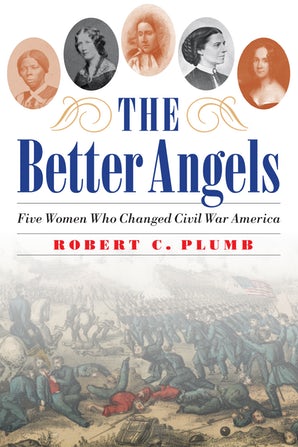
The Better Angels : Five Women Who Changed Civil War America Robert C. Plumb
Harriet Tubman, Harriet Beecher Stowe, Clara Barton, Julia Ward Howe, and Sarah Josepha Hale came from backgrounds that ranged from abject enslavement to New York City’s elite. Surmounting social and political obstacles, they emerged before and during the worst crisis in American history, the Civil War. Their actions became strands in a tapestry of courage, truth, and patriotism that influenced the lives of millions—and illuminated a new way forward for the nation.
In this collective biography, Robert C. Plumb traces these five remarkable women’s awakenings to analyze how their experiences shaped their responses to the challenges, disappointments, and joys they encountered on their missions. Here is Tubman, fearless conductor on the Underground Railroad, alongside Stowe, the author who awakened the nation to the evils of slavery. Barton led an effort to provide medical supplies for field hospitals, and Union soldiers sang Howe’s “Battle Hymn of the Republic” on the march. And, amid national catastrophe, Hale’s campaign to make Thanksgiving a national holiday moved North and South toward reconciliation.
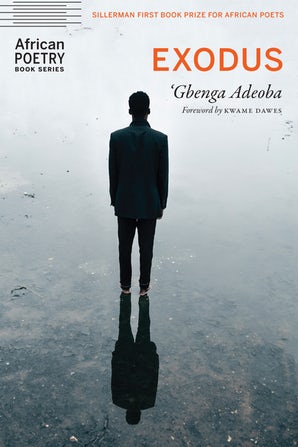
Exodus ‘Gbenga Adeoba (Series: African Poetry Book Series)
Winner of the Sillerman First Book Prize for African Poetry, ‘Gbenga Adeoba’s collection Exodus focuses on forms of migration due to the slave trade, war, natural disasters, and economic opportunities.
Using the sea as a source of language and metaphor, Adeoba explores themes of memory, transition, and the intersections between the historic and the imagined. With great tenderness and power his poetry of empathy searches for meaning in sharply constructed images, creating scenes of making and unmaking while he investigates experiences of exile and displacement across time and place.
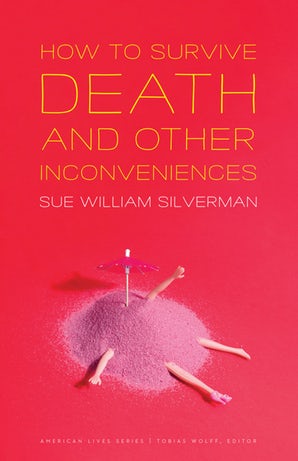
How to Survive Death and Other Inconveniences Sue William Silverman (Series: American Lives)
Many are haunted and obsessed by their own eventual deaths, but perhaps no one as much as Sue William Silverman. This thematically linked collection of essays charts Silverman’s attempt to confront her fears of that ultimate unknown. Her dread was fomented in part by a sexual assault, hidden for years, that led to an awareness that death and sex are in some ways inextricable, an everyday reality many women know too well.
Through gallows humor, vivid realism, and fantastical speculation, How to Survive Death and Other Inconveniences explores this fear of death and the author’s desire to survive it. From cruising New Jersey’s industry-blighted landscape in a gold Plymouth to visiting the emergency room for maladies both real and imagined to suffering the stifling strictness of an intractable piano teacher, Silverman guards her memories for the same reason she resurrects archaic words—to use as talismans to ward off the inevitable. Ultimately, Silverman knows there is no way to survive death physically. Still, through language, commemoration, and metaphor, she searches for a sliver of transcendent immortality.

In the Mean Time : Temporal Colonization and the Mexican American Literary Tradition Erin Murrah-Mandril (Series: Postwestern Horizons)
The 1848 Treaty of Guadalupe Hidalgo, which transferred more than a third of Mexico’s territory to the United States, deferred full U.S. citizenship for Mexican Americans but promised, “in the mean time,” to protect their property and liberty. Erin Murrah-Mandril demonstrates that the U.S. government deployed a colonization of time in the Southwest to insure political and economic underdevelopment in the region and to justify excluding Mexican Americans from narratives of U.S. progress. In In the Mean Time, Murrah-Mandril contends that Mexican American authors challenged modern conceptions of empty, homogenous, linear, and progressive time to contest U.S. colonization.
Taking a cue from Latina/o and borderlands spatial theories, Murrah-Mandril argues that time, like space, is a socially constructed, ideologically charged medium of power in the Southwest. In the Mean Time draws on literature, autobiography, political documents, and historical narratives composed between 1870 and 1940 to examine the way U.S. colonization altered time in the borderlands.
Rather than reinforce the colonial time structure, early Mexican American authors exploited the internal contradictions of Manifest Destiny and U.S. progress to resist domination and situate themselves within the shifting political, economic, and historical present. Read as decolonial narratives, the Mexican American cultural productions examined in this book also offer a new way of understanding Latina/o literary history.
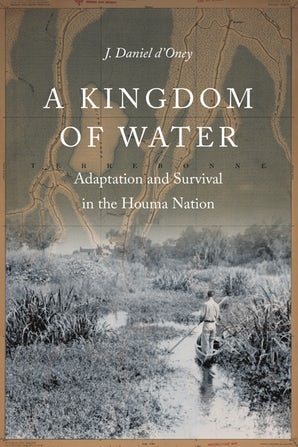
A Kingdom of Water : Adaptation and Survival in the Houma Nation J. Daniel d’Oney (Series: Indians of the Southeast)
A Kingdom of Water is a study of how the United Houma Nation in Louisiana successfully navigated a changing series of political and social landscapes under French, Spanish, British, and American imperial control between 1699 and 2005. After 1699 the Houma assimilated the French into their preexisting social and economic networks and played a vital role in the early history of Louisiana. After 1763 and Gallic retreat, both the British and Spanish laid claim to tribal homelands, and the Houma cleverly played one empire against the other.
In the early 1700s the Houma began a series of adaptive relocations, and just before the Louisiana Purchase in 1803 the nation began their last migration, a journey down Bayou Lafourche. In the early 1800s, as settlers pushed the nation farther down bayous and into the marshes of southeastern Louisiana, the Houma quickly adapted to their new physical environment. After the Civil War and consequent restructuring of class systems, the Houma found themselves caught in a three-tiered system of segregation. Realizing that education was one way to retain lands constantly under assault from trappers and oil companies, the Houma began their first attempt to integrate Terrebonne Parish schools in the early twentieth century, though their situation was not resolved until five decades later. In the early twenty-first century, the tribe is still fighting for federal recognition.

Sacrament of Bodies Romeo Oriogun (Series: African Poetry Book Series)
In this groundbreaking collection of poems, Sacrament of Bodies, Romeo Oriogun fearlessly interrogates how a queer man in Nigeria can heal in a society where everything is designed to prevent such restoration. With honesty, precision, tenderness of detail, and a light touch, Oriogun explores grief and how the body finds survival through migration.
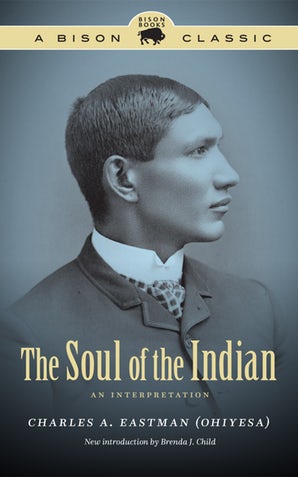
The Soul of the Indian : An Interpretation Charles A. Eastman (Ohiyesa) (Series: Bison Classic Editions)
The Soul of the Indian is Charles A. Eastman’s exploration and documentation of religion as he experienced it during the late nineteenth century. A Dakota physician and writer who sought to bring understanding between Native and non-Native Americans, Eastman (1858–1939) became one of the best-known Native Americans of his time and a significant intellectual figure whose clarity of vision endures today.
In a straightforward manner Eastman emphasizes the universal quality and personal appeal of his Dakota religious heritage. First published in 1911, The Soul of the Indian draws on his childhood teaching and ancestral ideals to counter the research written by outsiders who treated the Dakotas’ ancient worldviews chiefly as a matter of curiosity. Eastman writes with deep respect for his ancestors and their culture and history, including a profound reverence for the environment, animals, and plants. Though written more than a century ago, Eastman could be speaking to our own time with its spiritual confusion and environmental degradation. The new introduction by Brenda J. Child grounds this important book in contemporary studies.
**All synopses courtesy of University of Nebraska Press (https://www.nebraskapress.unl.edu/)
The 2020 Census is Still Going Strong!
2020 Census Infogram
Posted in Census, Education & Training, General, Information Resources, Technology, What's Up Doc / Govdocs
Tagged census
Leave a comment
A Phased Library Reopening Plan
Many Nebraska libraries have closed their buildings to the public during the COVID-19 pandemic; some stopped all physical services completely, and others developed alternative services. The Nebraska Library Commission has put together some guidance of how libraries can begin to reopen their buildings and restore services.
Phased Plan for Reopening Nebraska Libraries
This plan will provide a phased outline of how full services could be restored as the health crisis eases and social distancing measures end. It can be used as a starting point for library directors and their boards to determine the specific course of action their library will take to serve their community during and after the pandemic.
Disclaimer: This document is intended as guidance only. The Nebraska Library Commission does not have the authority to mandate that libraries close or open in any capacity. Library directors should work with their library boards, local government, and local health departments to determine their course of action. Libraries may modify this plan to suit their needs.
We will continue to update this plan as new information is available. See all of our COVID-19 resources for libraries and Nebraskans here: http://nlc.nebraska.gov/libman/pandemic.aspx
Posted in General, Information Resources, Library Management
Tagged coronavirus, covid-19, pandemic, reopening
Leave a comment
OverDrive Data
For today, we are looking at some data as it relates to libraries offering alternative services during the COVID-19 crisis. Specifically, we are looking at a potential shift to electronic resources, in this case, OverDrive. But first, I want to provide a link to the fantastic data that is being put out by the Nebraska Department of Labor. From the DOL main page, I was looking mostly under their resources, then INFOLink pages, for raw data about unemployment statistics and claims. Next, I found their visualizations, which are excellent, and detail unemployment claims by county with maps, and some very illustrative charts. If you have a chance, visit their visualizations HERE.
Now, to OverDrive. From my colleague here at NLC, I got some data about new OverDrive users, and OverDrive circulations. I was curious to see if there was a correlation between new users and circulations as many libraries shut down operations or offered modified services, such as curbside pickups. The first graphic illustrates libraries with new OverDrive users, and the total number of new users, for the weeks beginning in January, 2020:
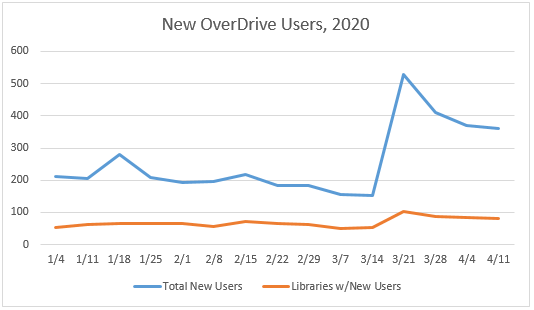
As the chart illustrates, there was a spike during the week of March 14 – 21, then a leveling off. Next, I looked at OverDrive circulations, and you guessed it, they increased:
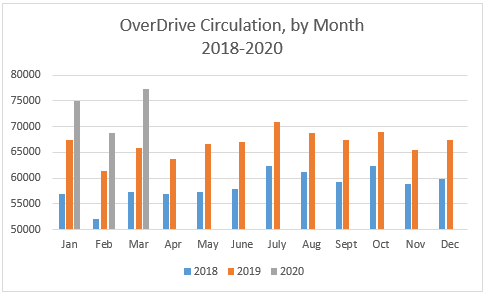
But wait. There’s more to this chart. For this one, I visualized the data from the previous 2 years, 2018 and 2019. If we look at March, we see the large spike in OverDrive circulations from 2019 to 2020, but it helps to put this in perspective. Between March, 2018 and March, 2019, circulations increased at a rate of 15.07%. From March, 2019 to March, 2020, circulations increased at a rate of 17.33%. So a slightly higher percentage of circulation growth compared to the prior year. For February, the 18-19 increase (17.98%) was higher than the 19-20 increase (12.15%). April data might be the telling point to look at, and I intend to post about that when it becomes available.
Getting Started with NebraskAccess
Learn more about using NebraskAccess databases and share this information with all of your library users!
NebraskAccess provides Nebraska residents with free 24/7 access to premium databases containing thousands of full text popular magazine and journal articles; primary source documents; genealogical, health, legal, small business, and science resources; reading recommendations; and research resources for K-12 students. These resources are available to Nebraska residents at no cost. The Nebraska Library Commission purchases subscriptions for Nebraskans with funding from the State of Nebraska and the U.S. Institute of Museum and Library Services.
NebraskAccess also offers ALL site visitors access to a directory of topically-arranged websites evaluated and compiled by Nebraska Library Commission reference librarians, and links to full text Nebraska state government publications and digitized Nebraska historical resources.
Posted in Education & Training, General, Information Resources
Tagged Databases, NebrasAccess, Nebraska
Leave a comment
2020 Census Operational Adjustments

The 2020 Census is underway and more households across America are responding every day. Over 70 million households have responded to date, representing over 48% of all households in America. In light of the COVID-19 outbreak, the U.S. Census Bureau is adjusting 2020 Census operations in order to:
• Protect the health and safety of the American public and Census Bureau employees.
• Implement guidance from federal, state and local authorities.
• Ensure a complete and accurate count of all communities.
The Census Bureau temporarily suspended 2020 Census field data collection activities in March. Steps are already being taken to reactivate field offices beginning June 1, 2020, in preparation for the resumption of field data collection operations as quickly as possible following June 1.
In-person activities, including all interaction with the public, enumeration, office work and processing activities, will incorporate the most current guidance to promote the health and safety of staff and the public. This will include recommended personal protective equipment (PPE) and social distancing practices.
Once 2020 Census data collection is complete, the Census Bureau begins a lengthy, thorough and scientifically rigorous process to produce the apportionment counts, redistricting information and other statistical data products that help guide hundreds of billions of dollars in public and private sector spending per year.
In order to ensure the completeness and accuracy of the 2020 Census, the Census Bureau is seeking statutory relief from Congress of 120 additional calendar days to deliver final apportionment counts.
Under this plan, the Census Bureau would extend the window for field data collection and self-response to October 31, 2020, which will allow for apportionment counts to be delivered to the President by April 30, 2021, and redistricting data to be delivered to the states no later than July 31, 2021.
Posted in Census, Education & Training, General, Information Resources, Technology, What's Up Doc / Govdocs
Tagged census
Leave a comment

